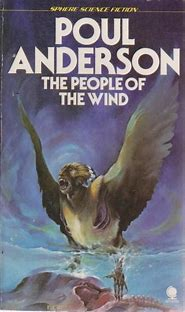Stormgate
Highsky
Weathermaker
Mistwood
The Tarns
Many Thermals
"Wings of Victory": the Grand Survey ship, Olga, under Captain Gray, discovers Ythri.
Hloch's introduction to "The Problem of Pain" tells us that the same Grand Survey expedition discovered both Ythri and Avalon.
"The Problem of Pain": Ythrians employing Aenean human beings explore Avalon, provisionally called "Gray."
"Wingless": human beings and Ythrians colonize the Hesperian Islands on Avalon.
"Rescue on Avalon": the colonists move to the Coronan continent.
"Lodestar": some Ythrians have become spacefarers.
The People of the Wind: the Terran Empire attempts to annex Avalon.
The Day of Their Return: Avalonian human beings have learned to live without governmental institutions.
If we, editorially speaking, reread The People of the Wind, it will be in search of details not noticed or recorded during previous readings.

5 comments:
Kaor, Paul!
Aren't you over stressing the Ythrian aspects of that first Grand Survey? That expedition also discovered MERSEIA, which some might think far more portentous, considering what resulted from it.
Ad astra! Sean
Sean,
Well, yes, I was focusing on Ythrians and particularly on Avalon.
Paul.
Kaor, Paul!
It was fortunate for the Empire that Terra failed to annex Avalon. That small setback made it possible for a Ythrian agent from there to play a crucial role in thwarting Merseian designs on Aeneas that could have convulsed and shattered the Empire.
"Day of Burning" shows us several different options Merseia might have taken in its future history. Unfortunately, the advocates of what we both agree were bad strains of thought won out.
There was at least one more Grand Survey after the first. A pity Anderson never wrote a story using the second Grand Survey.
Ad astra! Sean
I think I noted that there were many parallels between Merseia and post-Tokugawa Japan.
One of them was that an intensely nationalist alliance of oligarchs and the old aristocracy ended up running things.
In Japan, that lasted until 1945, and only ended because we hammered Japan into a pulp.
Before then, Japan was in many respects a really nasty place.
Kaor, Mr. Stirling!
I agree, with the caveat that during Emperor Taisho's reign Japan did show some signs of becoming a mild constitutional monarchy. There were other strains of thought within Japan at that time besides aggressive extreme nationalism.
IOW, rather like the Star Believers we see in "Day of Burning."
Ad astra! Sean
Post a Comment